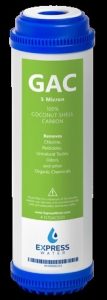Sulfur is a common mineral found in water. While it doesn’t typically cause any problems, some people may find the smell of sulfur unpleasant. If you have any in your water, you may be wondering if reverse osmosis can remove sulfur.
Sulfur in your drinking water can be in one of several forms – the most common are sulfite, sulfate, and hydrogen sulfide. Depending on which type of sulfur you have, reverse osmosis will remove varying amounts of this compound. RO removes more than 99% of sulfite and sulfate from drinking water. Hydrogen sulfide will pass through the RO membrane untreated – however, some of the H2S will be removed by the activated carbon pre- and post-filters on the RO system.
In this blog post, we will answer the question: does reverse osmosis remove sulfur? Keep reading to learn more!
About sulfur
Sulfur is the fifth most common element on Earth and is the third most abundant mineral in the human body. It is found in nature as sulfide and sulfate minerals.
Sulfur is considered an essential element in living cells and is found in some amino acids, such as cysteine and methionine. It plays an important role in the detoxification of the body, particularly in the liver. It is also necessary for the production of collagen and cartilage.
What is sulfur
Sulfur can be present in your drinking water in one of several forms. These include:
- sulfate – SO4 is a major component of rainwater. Most sulfate compounds come from the oxidation of sulfite ores, the presence of shales, or industrial waste discharges.
- sulfite – Sulfites are compounds that contain the sulfite ion, SO²⁻. They are naturally found in water and some foods.
- hydrogen sulfide – H₂S is a colorless gas that smells like rotten eggs
Health concerns with sulfur
Sulfates present a relatively minor risk to our health. In sensitive individuals, sulfates can cause lung irritation, dry skin, dermatitis, and edema.
Sulfites do not cause serious health effects, but some people are sensitive to them. Reactions to sulfites can include diarrhea, dermatitis, flushing, and abdominal pain. In rare cases, they can cause anaphylactic and asthmatic reactions.
Hydrogen sulfide, in low concentrations, is not a health concern. It does, however, smell like rotten eggs, and can cause nausea, vomiting, diarrhea, and headaches. In high concentrations – above 150 parts per million (ppm) – it can be toxic. It also corrodes pipes and plumbing fixtures.
Drinking water standard for sulfur
The EPA set a secondary maximum contaminant level (MCL) for sulfate at 250 mg/L, but no MCL has been set for sulfide or hydrogen sulfide.
The EPA does not regulate private drinking water, so there is no drinking water standard if you have a well.
Reverse Osmosis
Reverse osmosis is a widely used treatment method that reliably removes a wide range of contaminants from drinking water. It is effective at reducing the concentration of impurities such as lead, PFAS, and heavy metals
How RO works
Reverse osmosis systems use a semipermeable membrane to remove impurities from water. The membrane allows water to flow through while trapping dissolved solids and other contaminants. The system applies pressure to the water, forcing it through the membrane and removing any impurities.
The membrane is constructed of a semi-permeable polymer that is spirally wrapped around a central tube. The water is forced through the membrane, and the impurities are filtered out. The clean water is then collected on the other side of the membrane, while the contaminants are retained in a concentrated brine. This brine waste is then flushed down the drain.
Reverse osmosis systems can be used to treat both municipal water supplies and private wells. They are effective at removing a wide range of contaminants, including lead, bacteria, viruses, pesticides, and more.
RO system components
Reverse osmosis systems typically consist of three modules:
- pretreatment
- reverse osmosis membrane
- post-filter


Pretreatment protects the membrane from fouling and damage caused by chlorine. It usually consists of a sediment filter and an activated carbon filter. The sediment filter removes particles such as dirt and rust, while the activated carbon filter removes chlorine and other chemicals.
The reverse osmosis membrane is the heart of the system. It’s a thin film composite (TFC) that remove contaminants from water. The TFC is made of several layers of material, including a semi-permeable membrane.
The post-filter is a final stage of filtration that removes any remaining impurities from the water. This is typically a second carbon filter that ensures the water is safe to drink and tastes great.
Some RO systems include a water storage tank, which stores the clean water until you’re ready to use it. This is desirable because the flow rate through the filter is slow. Having a storage tank ensures you can fill a glass or a cooking pot quickly with clean water without having to wait.
How Well Does Reverse Osmosis Treat Sulfur
A reverse osmosis filter or granulated activated carbon can remove small amounts of hydrogen sulfide from drinking water. However, these technologies are not very effective in removing it alone.
How much sulfur can reverse osmosis remove
Reverse osmosis is very effective at treating sulfate and sulfite in drinking water.
Reverse osmosis can remove 99 to 99.99% of sulfate in water. Reverse osmosis can remove 99 to 99.9% of sulfite in water.
Reverse osmosis does not effectively remove hydrogen sulfide from water. This is because, in water, hydrogen sulfide is a dissolved gas and passes through the RO membrane.
The activated carbon filter that virtually every reverse osmosis system has can remove some of the hydrogen sulfide. The amount of hydrogen sulfide remove by the carbon filter depends on the type of carbon and how much is in the filter element. The average amount of hydrogen sulfide removed by the carbon filters on an RO system is between 15 and 65%.
Challenges with sulfur and RO
Reverse osmosis filters are not especially effective at removing hydrogen sulfide. The carbon filter included with the system can remove some of the H₂S but can’t remove all of it. At low levels of hydrogen sulfide (0.3 ppm), the carbon will work fine. At higher concentrations, the remaining H2S will be noticeable.
Therefore, RO filters are not considered to be effective at removing hydrogen sulfide. You should use another treatment method if the sulfur in your drinking water is hydrogen sulfide.
What Treatment Methods Remove Sulfur from Water
Hydrogen sulfide can be removed from water in several ways. These include:
- oxidation
- aeration
- greensand
- ion exchange
Factors to Consider with Reverse Osmosis
If you’re concerned about the quality of your drinking water, a reverse osmosis filter may be a good option for you. RO filters are able to remove a variety of contaminants from your water, including lead, mercury, and chlorine. However, there are a few factors you should consider.
Installation cost of reverse osmosis
Depending on your home’s plumbing, installing an RO system can be relatively simple or quite complex. If your home has a standard under-sink configuration, you can likely install the filter yourself. However, if your home has multiple faucets or you need to drill new holes for the filter, it’s best to hire a professional.
A whole-house RO system can be expensive to install, especially if you have to modify your home’s plumbing. An under-sink unit, on the other hand, can often be installed by a good do-it-yourselfer for a reasonable cost. Each home is unique, so you’ll have to determine which system is right for you.
Maintenance cost
RO filters have sediment filters and activated carbon filters that have to be replaced. A sediment filter will usually last for about six months before it needs to be replaced. Carbon filters have to be replaced every 3 to 6 months, depending on how much water you use and the amount of chlorine in your water.
The cost of replacement filters can vary, but you can expect to spend around $60 to as much as $200 per year on them. Whole house filters are 3 to 4 times as much as under-sink filters.
While this may seem like a lot, it’s important to remember that RO filters can remove a variety of contaminants from your water, making it safer and healthier to drink.
Whole-house versus under-sink units
Another thing to consider is how much water you’ll need to filter. RO filters are typically sized according to the number of gallons they can process per day. If you have a large family or use a lot of water for cooking and bathing, you may need a larger filter.
Reverse osmosis systems are available in a wide range of sizes, from small countertop units to large industrial systems. They can be used for point-of-use (POU) applications, such as filtering water for a kitchen sink, or point-of-entry (POE) applications, such as filtering all the water coming into your home.
Deciding which type of RO system is right for you depends on a number of factors, including your budget, the size of your home, and your water quality. Read my article on under-sink RO systems and whole-house RO systems for a detailed explanation.
NSF certification
Reverse osmosis filter manufacturers often make claims about how well their units remove contaminants. The best way to be certain of their claims is to look for units that have been certified by NSF International.
NSF is an independent organization that tests and certifies products to ensure they meet strict standards for quality and safety. If a product has been certified by NSF, you can be confident it will perform as advertised.
The applicable standard for point-of-use reverse osmosis systems is NSF/ANSI 58. It covers the following parameters:
- Materials of construction and leaching of harmful substances
- Mechanical integrity
- Removal of total dissolved solids (TDS)
- Efficiency rating
- Recovery rating
- Contaminant concentration reduction
FAQs
Does activated carbon remove sulfur?
Activated carbon can remove sulfate and sulfite from water. It is marginally effective at removing low levels of hydrogen sulfide. High concentrations of H₂S should be treated with other methods.
Does boiling water remove sulfur?
Boiling water will not remove sulfates or sulfites from water. In fact, boiling will concentrate these compounds as the water evaporates.
Boiling water will remove hydrogen sulfide from water. This is because H₂S is a gas and will volatize when the water is boiled.
Does a water softener remove sulfur?
A conventional water softener does not remove sulfur from water. The ion exchange resin is effective at removing calcium and magnesium (hardness), but it does not treat hydrogen sulfide, sulfate, or sulfite.
Conclusion
Reverse osmosis is an effective treatment method for sulfate and sulfite in drinking water. It is not, however, an effective method for removing hydrogen sulfide. If you have a problem with hydrogen sulfide in your water, you should use another treatment method such as aeration, oxidation, distillation, or greensand.

